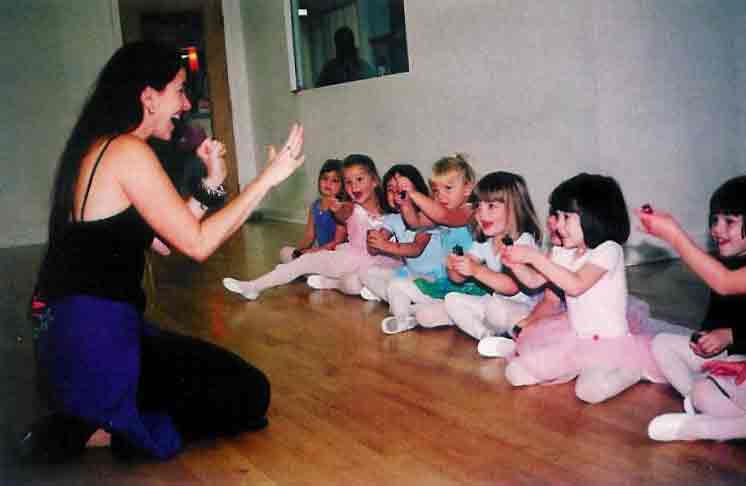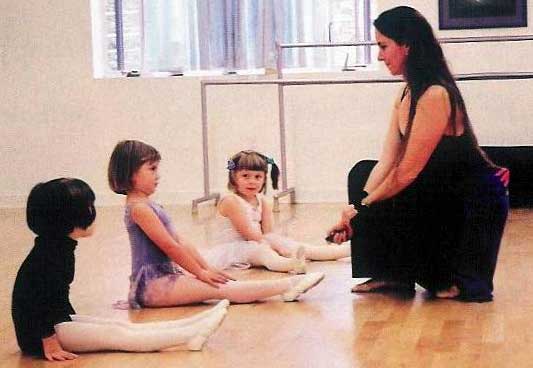
I clearly remember my first ballet teacher banging her cane inches from my feet. The fear was that if I didn't execute the steps perfectly, that cane would slam into my toes. As I grew up, the abrasive style of some of my subsequent teachers was even more devastating. So, when I began my own teaching career, I avowed to be different and, at first, I was. "Sweetie, please stand here. Darling, please don't talk in class. Point your foot, silly." I would say affectionately, earning a reputation for being a loving and nurturing teacher. But I only produced dancers of passable technique.
When I began taking students to competitions, my teaching style changed. I still made jokes and taught with a bag full of endearments, but my tone was different. We repeated movements endlessly until I was satisfied. Sometimes my frustration was too visible to the dancers. Although they improved and we became more successful each year, I struggled with the notion that I had to be harsh in order to get hard work and improvement from students.

The author teaches preballet students how to use clickers.
The Ambiguous "Good Job"
Many dancers are skilled at interpreting instructors' body language and second-guessing what teachers say. Upon hearing the ubiquitous "good job," a student's inner monologue may process something like t his: Did she mean "good" as in "average" or "good" as in "excellent?" Was it truly better this time or was it better last time? And what about it was good? The height in the jete, the straight arms or the smile?
I discovered a solution through Theresa McKeon, my former college roommate and fellow dancer at Roger Williams College Dance Theatre in Rhode Island. A popular guest teacher known for using cross-disciplinary training, McKeon drew upon behavioral science to develop a training technique called Teaching with Acoustical Guidance (TAG), a total departure from correction-based teaching. We tested TAG on students during a dance-camp training session this past summer.

A student gets tagged for sitting up straight.
TAG Teaching
McKeon and her project partner, Canadian scientist Joan Orr, developed TAG with the intent of training athletes. TAG uses an acoustical signal generated by a small, handheld device called a clicker to neatly sidestep traditional verbal correction-based teaching. I believe it is one of the most positive tools ever introduced to dance teaching. Its mantra, "Tag, don't nag," suggests that he most effective way to bypass emotional (negative) teaching I to utilize a child's immediate reaction to positive reinforcement - a conditioning that emphasizes what a child does correctly. The idea is that if children are singled out when they do something right, they will be conditioned to repeat it.
Since the joy associated with success should not be diminished by identifying deficiencies, TAG teachers never say, "Good job, but you didn't point your foot." Instead, the TAG teacher focuses on a single element of a step or one technical aspect, called a "tag point." For example, a tag point could be the execution of a pique arabesque with straight knees. When the dancer executes it correctly, the teacher rewards the student with a "tag," the click sound produced by the small handheld device. The rag becomes a binary message: a tag means yes, absence of a tag means no. The brain does not have to process corrections or interpret emotions while the body is trying to perform complicated movements. Instead, the TAG-trained dancer learns to react to this data with lightning speed while building muscle memory and confidence. Technical skills are developed one tag point at a time, and fewer repetitions are needed because the approach is so targeted and specific.
The kind of training is not new; behavioral scientists have been studying the effects of positive reinforcement for decades. The late Harvard professor B.F. Skinner's extensive studies in operant conditioning and ethologist Konrad Lorenz' meticulous study of behavior characteristics paved the way for the lauded works of husband-and-wife team Keller and Marian Breland as well as Ron Turner and Karen Pryor-all pioneers in the field.
The technical definition of operant conditioning is conditioning behaviors through a variety of shaping techniques, schedules and reinforcements. In other words, a stimulus can be used t encourage certain behaviors. In TAG teaching, the stimulus is the click of the device. For instance, students learn that when they pique arabesque with straight knees, they receive a click. After repetitions, muscle memory will create the habit to always pique arabesque with straight knees.
Behavioral scientist Karen Pryor, whose bestselling Don't Shoot the Dog helped mainstream this type of training, visited my school to observe the progress students were making under TAG. "Kids who are corrected for an hour can't help feeling frustrated," Pryor said. "This way, they can focus on learning and the frustration is gone. It's a fun and effective way to teach behavior." For added variation, Orr recommends that students tag each other. "When you tag your partner, says Kimmie Pfister, 10, "you can both learn how to do it correctly."

The author and students wielding their clickers.

The Results
My students grasped the idea of tagging immediately. "It's either a click or it's not a click," noted Jake Corcoran, 9, after a tagging class. The results have been astounding. How many times have you told your dancers to keep their heels down in demi plie? With a group of twenty-five 7- to 9-year olds, each child was able to master the skill after one tag session. Subsequent classes focusing on everything from grand jete's to battements met with similar success. Pryor observed, "The great thing about [this] training is that when you can't quite do [a step], you know exactly what you have to reach for, what you have to learn."
Plus, it's fun. Dancers "make" the teacher tag them by executing a movement correctly, so al the control is in the student's hands. Young dancers especially seem to enjoy what they think of as a game. They say, "See what I can make you do."
The TAG method teaches the teacher as much as it teaches the dancer because it requires instructors to dissect and explain every step in advance in order to select an appropriate tag point. It also facilitates discussion between dancers and teachers when they collectively seek to determine the one movement at the core of a port de bras, shuffle step, straddle leap, etc.
Tagging works where traditional teaching can fail because the latter may often be implicitly negative. When you point out an error, you are essentially reinforcing it, and students are sometimes unable to see corrections as compliments, no matter how often you tell them that a correction means a teacher cares about their improvement. TAG teaching only reinforces correct dancing. The tag says, "Yes, do that again."
I believe TAG is the single most positive change I have made in my business since opening my studio more than 20 years ago. My dancers are thriving physically and emotionally, my teachers are inspired and refreshed, parents are pleased that I have taken such a step to endure that our mission is about the whole child, not just winning a competition. It is possible to train dancers to be technically excellent without h arming them emotionally, and this is an educational foundation so far removed from the studios of my youth that I all but cheer.
A Dancer's Dream offers classes for all ages (starting at 2 1/2 years) in a variety of styles. For more information, contact the studio at 781-631-8978 or visit www.adancersdream.net. For more info on tagging check out: www.tagteach.com



Post new comment